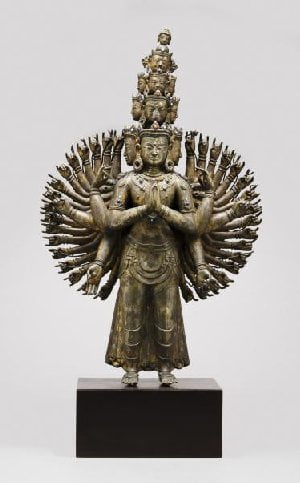Avalokiteśvara or Chenrezik represents the essence of the speech of all the buddhas and also embodies all of their compassion. Often invoked as ‘The Great Compassionate One’, he is known as one of the Eight Great Bodhisattvas. His name can be translated as ‘the lord who looks in all directions or ‘the all-seeing lord’. In Cambodia and Thailand, he is known as Lokeśvara, the ‘Lord of the World.’ In China, he is customarily worshipped in female form, as Guanyin ‘Hears Cries’. And in Sri Lanka, he is commonly referred to as Nātha-dēviyō and is supplicated in that sea-going culture, especially for the prevention of shipwrecks. In some tantras, he is one of the lords of the three families, embodying the compassion of all buddhas. In Tibet, he is seen as a special protector of Tibet, and both the Dalai Lama and Karmapa incarnations are said to be emanations of Chenrezik.
In the Mahāyāna sutra, The King of the Array of All Dharma Qualities, the bodhisattva Vajrapāṇi poses a number of questions to the Buddha:
Blessed One,” asked the bodhisattva Vajrapāṇi, why did Avalokiteśvara receive the name ‘Avalokiteśvara (The Lord Who Sees)’?”
“Because he sees and surveys the entire world; brings contentment, protection, and relief; has a compassionate, benevolent, loving, and affectionate mind; and completely fulfills all aspirations, he is named ‘Avalokiteśvara.’ ”
The bodhisattva Vajrapāṇi then said, “Blessed One, just to contemplate Avalokiteśvara’s name completely fulfills all one’s aspirations…
The Noble Great Vehicle Sūtra: The King of the Array of All Dharma Qualities, trans. By Dharmachakra Translation Committee.
According to modern scholars, the earliest reference to Avalokiteśvara occurs alongside Amitābha in the Sukhāvatīvyūha Sūtra, The Display of the Pure Land of Sukhāvatī. Chapter 25 of the Saddharma Puṇḍarīka (Lotus) Sūtra also has a lengthy description of the vows and aspirations made by Avalokiteśvara out of his great compassion. In that text, the Buddha explains to Bodhisattva Akṣayamati the innumerable practices of Avalokiteśvara and his ability to manifest in myriad forms to benefit beings.
Listen to the practices of Avalokiteśvara,
Which have their application to all!His vow is deep like the ocean
And his kalpa is of inconceivable length.After having attended
Many thousands of koṭis of buddhas,
He made a great, pure vow.I will now explain it to you in brief:
If you hear his name and see his body,
And contemplate him in thought,
Your life will not be in vain;
And you will extinguish all suffering…The pure seer Avalokiteśvara will be a refuge
When suffering distress or the misery of death.He is endowed with every quality,
Sees the sentient beings with his benevolent eyes,
And his ocean of merit is immeasurable;For this reason you should pay him homage.
Saddharma Puṇḍarīka Sūtra, Chapter 25
One prominent Buddhist story tells of Avalokiteśvara vowing never to rest until he had freed all sentient beings from cyclic existence. Despite all his efforts, he realized that still many unhappy beings still suffered. This inconceivable situation caused his head to split into eleven pieces. Amitābha Buddha then gave him eleven heads with which to hear the cries of the suffering. When he heard this suffering, Avalokiteśvara attempted to reach out to all those who needed aid but found that his arms were shattered into pieces. Once more, Amitābha bestowed upon him a thousand arms with which to aid the suffering multitudes.
The six-syllable mantra of Avalokiteśvara, Oṃ maṇi padme hūṃ is ubiquitous in Tibet, on the lips of practitioners and carved throughout the land on rocks and prayer wheels. The first known textual source is the Mahāyāna Kāraṇḍavyūhasūtra where he is also referred to as Ṣaḍākṣarī, ‘Lord of the Six Syllables ‘. According to Tibetan chronicles the text of the Kāraṇḍavyūhasūtra landed in a casket from the sky atop the palace roof of the 28th king of Tibet, Lha Thothori Nyantsen (d.650 C.E.,) in southern Tibet. The text remained undeciphered until it was translated into Tibetan in the 8th c. CE by the Indian paṇḍitas Jinamitra, Bandé Yeshé Dé and others.
Iསྐྱབས་གནས་ཀུན་འདུས་ངོ་བོ་བཀའ་དྲིན་ཅན། །
kyabné kündü ngowo kadrin chen
In essence you are the embodiment of all sources of refuge,བླ་མ་སྤྱན་རས་གཟིགས་ལ་གསོལ་བ་འདེབས། །
lama chenré zik la solwa dep
Gracious lama—Avalokiteśvara, to you I pray!ཨོཾ་མ་ཎི་པདྨེ་ཧཱུྃ།
om mani padme hung
oṃ maṇi padme hūṃཨོཾ་མ་ཎི་པདྨེ་ཧཱུྃ།
om mani padme hung
oṃ maṇi padme hūṃཨོཾ་མ་ཎི་པདྨེ་ཧཱུྃ།
om mani padme hung
oṃ maṇi padme hūṃརྗེ་བཙུན་བླ་མར་བྱིན་གྱིས་རློབས། །
jetsün lamar chin gyi lop
Venerable master, grant your blessings!ཐུགས་རྗེ་ཆེན་པོས་བྱིན་གྱིས་རློབས། །
tukjé chenpö chin gyi lop
Great compassionate one, grant your blessings!སྤྱན་རས་གཟིགས་ཀྱིས་བྱིན་གྱིས་རློབས། །
chenré zik kyi chin gyi lop
Avalokiteśvara, grant your blessings!འགྲོ་བའི་མགོན་པོས་བྱིན་གྱིས་རློབས། །
drowé gönpö chin gyi lop
Protector of beings, grant your blessings!འཇིག་རྟེན་དབང་པོས་བྱིན་གྱིས་རློབས། །
jikten wangpö chin gyi lop
Lord of the world, grant your blessings!རྒྱལ་སྲས་མཆོག་གིས་བྱིན་གྱིས་རློབས། །
gyalsé chok gi chin gyi lop
Supreme among Buddha’s heirs, grant your blessings!ཡིད་བཞིན་ནོར་བུས་བྱིན་གྱིས་རློབས། །
yizhin norbü chin gyi lop
Wish-granting jewel, grant your blessings!ཨོཾ་མ་ཎི་པདྨེ་ཧཱུྃ།
om mani padme hung
oṃ maṇi padme hūṃཨོཾ་མ་ཎི་པདྨེ་ཧཱུྃ།
om mani padme hung
oṃ maṇi padme hūṃཨོཾ་མ་ཎི་པདྨེ་ཧཱུྃ།
Excerpt from Prayer to Avalokiteśvara by Nyoshul Lungtok Tenpé Nyima.
om mani padme hung
oṃ maṇi padme hūṃ



